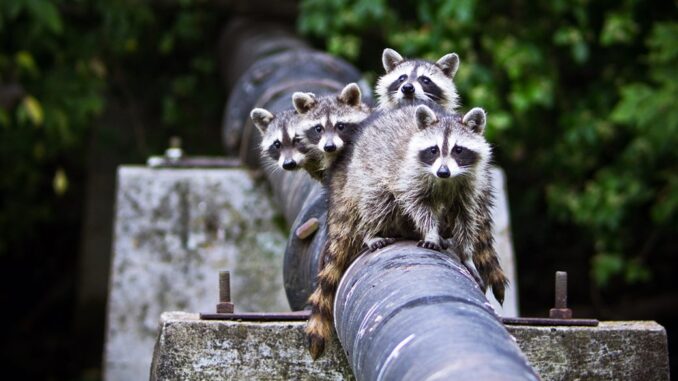
Known for their distinctive masked fur and mischievous nature, raccoons have earned a notorious reputation for raiding trash cans and breaking into homes in their perpetual search for food.
Table of Contents
Average Lifespan in the Wild
Raccoons in the wild generally have much shorter lifespans compared to raccoons kept in captivity. The average life expectancy for a raccoon in the wild is only 1.8 to 3.1 years. This is a stark contrast to captive raccoons, which can live for over 20 years.
There are several primary reasons why wild raccoons die at a relatively young age:
- Traffic – Many raccoons are killed each year by vehicles while attempting to cross roads. Roads that cut through or near forests are especially hazardous for raccoons.
- Hunting – Raccoon hunting is a popular activity in many areas. Some raccoons are hunted for their fur, while others are killed because they are seen as pests. Hunting accounts for a significant number of raccoon deaths each year.
- Severe weather – Harsh winters and extreme cold can lead to starvation and death for raccoons, especially young ones who have lost their mother. Long periods of intense cold decimate raccoon populations in northern climates.
- Disease – Diseases like canine distemper can spread rapidly among raccoons and wipe out entire communities. Epidemic diseases are a major cause of death for raccoons living in close proximity to one another.
So while raccoons can live to old age in controlled environments, the many perils of the wild mean most only survive for a few short years. Traffic, hunting, weather and disease all contribute to the raccoon’s short average lifespan in the wild.
Average Lifespan in Captivity
Raccoons that live in captivity can live over 20 years on average, which is significantly longer than their wild counterparts. Captive raccoons are provided with ideal conditions, nutrition and veterinary care, allowing them to live out their full potential lifespan.
In zoos, sanctuaries or as pets, raccoons are protected from the elements, predators, diseases, starvation and other dangers they would face in the wild. With a consistent food source and stimulating enrichment activities, captive raccoons maintain good health and may avoid stresses and injuries from having to forage, hunt and establish territory.
With preventative care and quick treatment for any illness, raccoons in captivity are less susceptible to infections or parasites that could claim their life prematurely. Their teeth and overall health is closely monitored by caretakers.
Thanks to this high level of care, it’s not uncommon for a pet or sanctuary raccoon to reach 25 years old. The world record for longest living raccoon in captivity was a pet raccoon named Rebecca who lived to be 28 years old.
Mating Season
Raccoons usually like to mate in times of increasing daylight, from January through March. However, one of the raccoon’s adaptive abilities is adjusting their mating season based on the region they live in. Mating seasons and times can differ across various parts of the raccoon’s habitat range. Their ability to adapt their breeding schedule allows them to maximize the seasonal resources available in any given area. This plasticity contributes to the raccoon’s reproductive success across diverse environments, which is one factor in their large population size.
Gestation Period
Raccoons usually breed between January and March. After mating, the gestation period lasts about 63-65 days before the female gives birth. This is a relatively short gestation period compared to some other mammals.
The embryo starts to develop during the first two weeks after conception. By week five, the major structures and organs are formed. Over the next two months, the embryos continue to grow and develop until they are ready to be born.
The timing of the breeding season allows the young raccoons (called kits) to be born in the spring when weather conditions are milder and food is more abundant. The kits have the best chance of survival if they are born at this optimal time of year.
The short gestation period and seasonal breeding cycle are important adaptations that contribute to the raccoon’s reproductive success and ability to thrive in a variety of environments.
Litter Size
A female raccoon usually gives birth to a litter of 3-5 kits each year. The average litter size is between 3 and 5 baby raccoons, though the litter number can vary from as small as 1 to as large as 7. The number of kits in a litter depends on factors like the age and health of the mother, food availability in the habitat, and seasonal timing.
Younger, first-time mothers tend to have smaller litters with fewer kits. Older, more experienced mothers that have mated and given birth before will often have larger litters. The abundance of food sources in an area also impacts litter size, as a mother must be able to get adequate nutrition while nursing her young. When food is scarce, litter sizes tend to be smaller.
The time of year and seasonal conditions play a role as well. Litter size is generally larger in the early spring months and smaller later in the summer or fall. This correlates with greater food availability and moderate climate early in the season being more favorable for successfully raising a bigger litter.
So while 3-5 kits is typical, a mother raccoon’s health, habitat, and the season all contribute to determining the number of babies she gives birth to and is able to care for. Her body is equipped to optimize reproductive success based on these variables.
Raising Young
Raccoons are very protective and nurturing mothers. After giving birth, the mother raccoon will care for her kits exclusively for about 8-16 weeks. During this time, she nurses, feeds, grooms, and teaches her kits the skills they need to survive on their own. The kits open their eyes after about 3 weeks and begin exploring outside the den after about 8 weeks.
While female raccoons invest significantly in raising their young, the males do not participate at all. After mating, the male raccoon leaves and does not provide any paternal care. The mother is left to raise the litter completely on her own. She will protect and defend them fiercely during those crucial first few months of life. This maternal dedication helps ensure the kits can grow to maturity and continue the species.
Adaptability
Raccoons are incredibly adaptable mammals, allowing them to thrive in a variety of environments. One key way raccoons demonstrate adaptability is by adjusting their mating seasons and litter sizes based on local conditions.
In ideal conditions with increasing daylight, raccoons will mate between January and March. However, in regions with high mortality rates, raccoons may mate earlier or more frequently to compensate. The typical raccoon gestation period is 63-65 days, but litters contain variable numbers of kits. In areas with plentiful resources and low predation, litters are smaller at around 3-4 kits. But in harsher conditions, females give birth to larger litters, sometimes up to 7 or 8 kits.
This reproductive adaptability allows raccoons to maximize their reproductive success despite local challenges like weather, lack of resources, or high mortality rates. So while an individual raccoon may have a short lifespan of only 1-3 years, overall populations are quite resilient thanks to adaptations like flexible mating and litter sizes. The raccoon’s ability to adjust to varied and changing environments is a key reason they remain widespread across North America today.
Urbanization
Raccoons have thrived in urban areas due to their exceptional adaptability and lack of natural predators. As humans expand into wild areas, raccoons have moved right along with us into cities and suburbs.
Raccoons are highly adaptable generalists that can make use of many food sources, from human trash to bird feeders. They have flexible diets and feed opportunistically. This allows them to adapt as habitats change with human development.
In urban areas, raccoons face few of their natural predators like wolves, bobcats or cougars. With plentiful food and shelter available from homes and buildings, urban raccoon populations grow rapidly.
Raccoons are also intelligent and develop clever ways to access food, like prying off garage door seals or opening closed trash bins. Their nimble paws allow them to raid many novel food sources. As generalists rather than specialists, raccoons can shift strategies and solve new problems, giving them an advantage in man-made environments.
While other species decline as development encroaches on native habitats, raccoons move in and multiply. Their adaptability lets them thrive amidst human expansion, leading to booming urban raccoon populations.
Conclusion
Raccoons have come a long way from when they were first discovered by European settlers in the Americas. They have managed to adapt and thrive in changing environments, mainly due to their intelligence and resourcefulness. A raccoon’s average lifespan is only 1.8-3.1 years in the wild, but they can live over 20 years in captivity. Their mating season is January-March, with a gestation period of 63-65 days and a typical litter size of 3-5 kits. The female raises the young for about 16 weeks before they set off on their own.
Raccoons are incredibly adaptable, as evidenced by their ability to thrive in urban environments alongside humans. Their intelligence certainly gives them an edge when it comes to problem-solving and survival. While they often get a bad rap as nuisance animals, raccoons are fascinating creatures that continue to prosper in a human-dominated world. Their adaptability ensures they will be around for a long time to come.

Leave a Reply